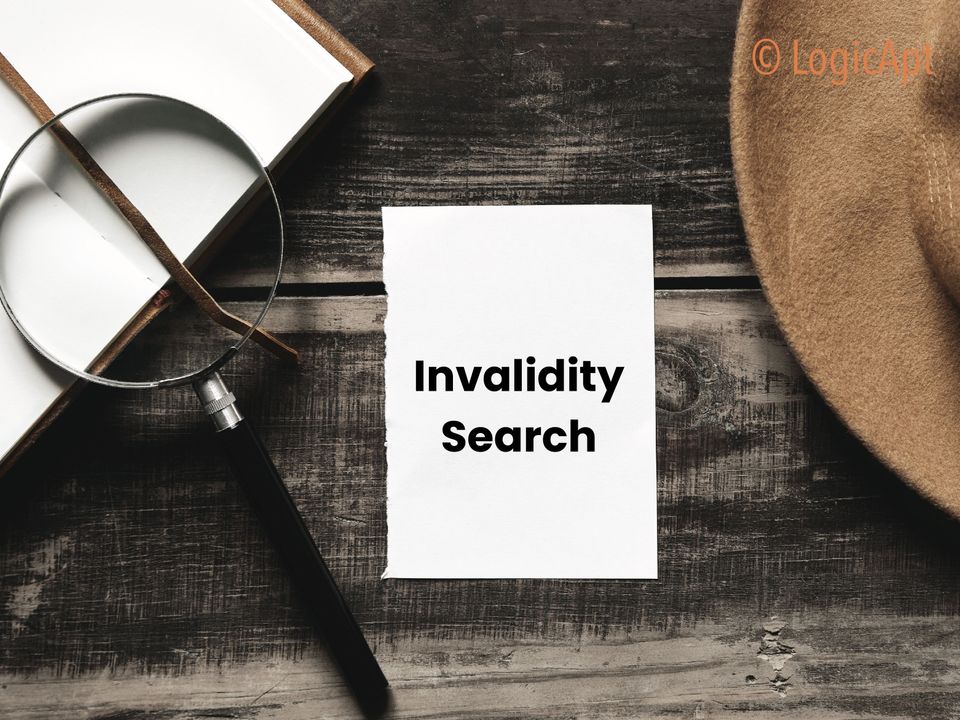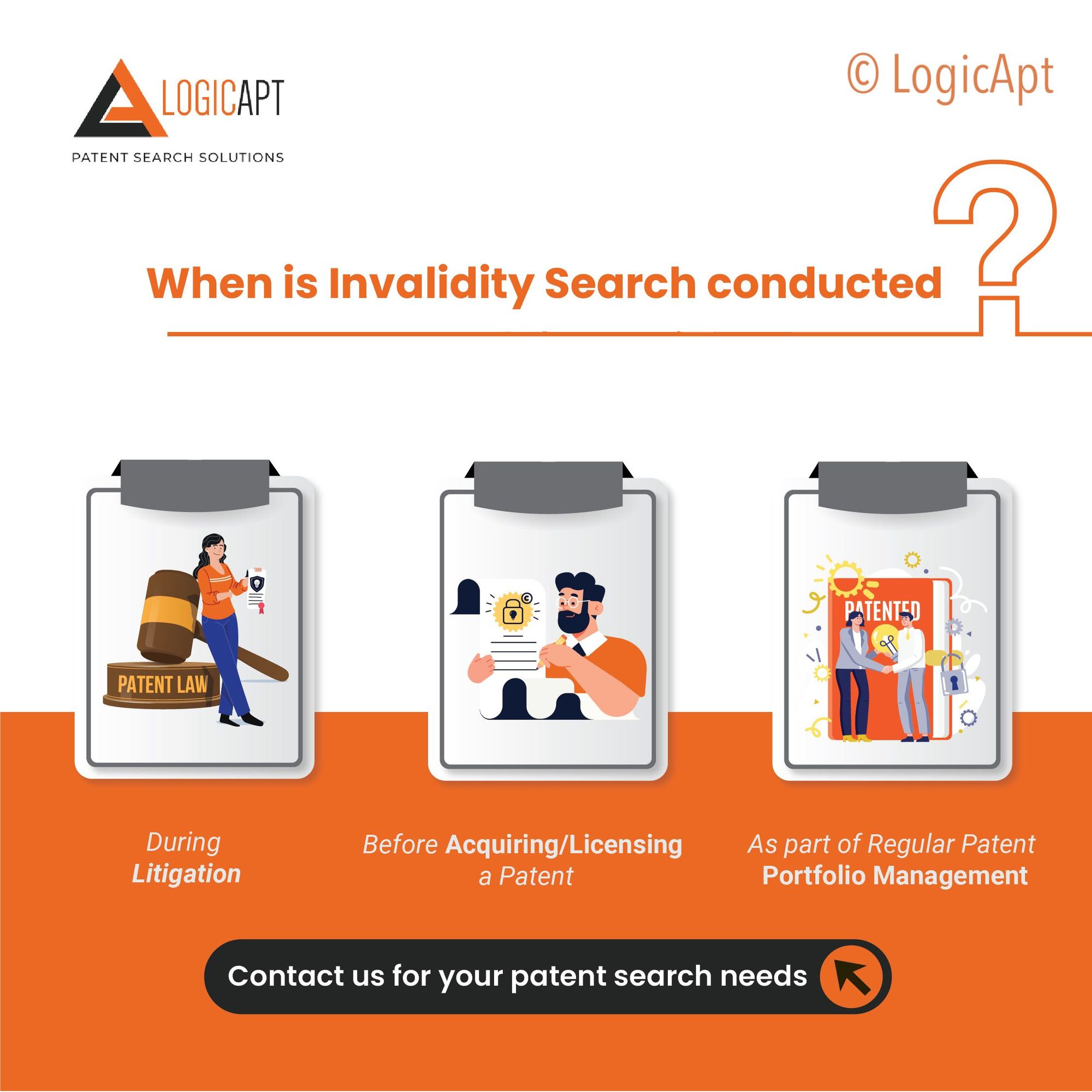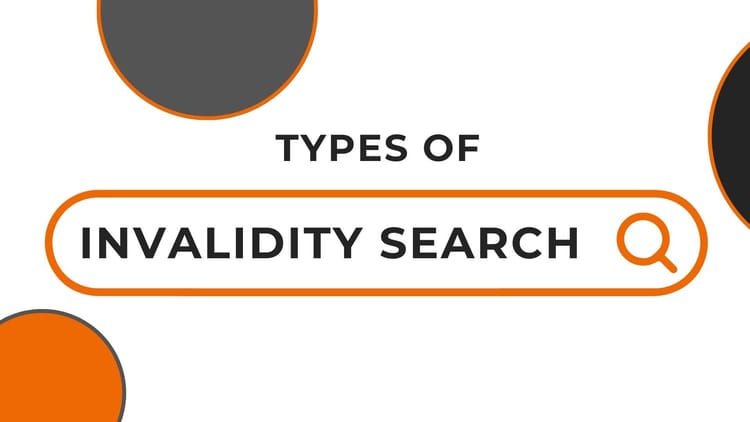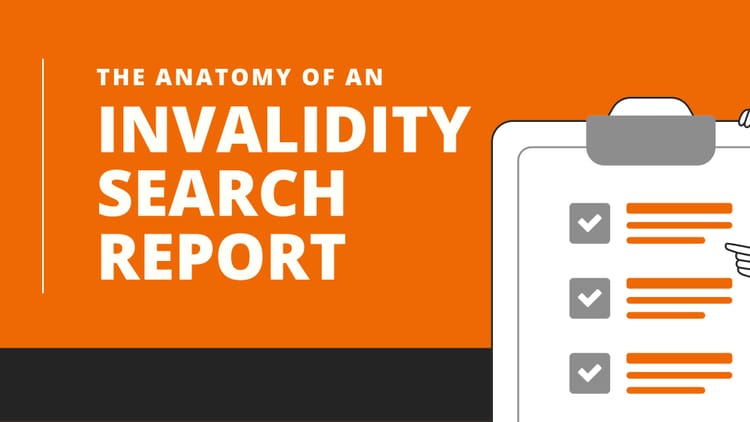What is an Invalidity Search?

Introduction
Imagine you're a license considering the acquisition of an existing patent to bolster your company's intellectual property portfolio. You may even be an attorney defending a client in a high-stakes patent infringement lawsuit. One tool can be your best ally or an unfortunate oversight in these scenarios: the invalidity search.
An invalidity search is a specialized form of research aimed at uncovering previously published materials or patents—known as "prior art"—that may negate the originality or validity of a given patent. This search type is often the linchpin in patent litigation cases and is vital in strategic decisions related to patent acquisition, licensing, and portfolio management.
In this blog, we will demystify the enigmatic world of invalidity searches. You'll learn what they are, why they are indispensable to various stakeholders, and how they are conducted. So whether you're a curious novice or a seasoned professional looking to improve your knowledge, you're in the right place. Let's dive in.
What Is An Invalidity Search?
Simply put, an invalidity search is a treasure hunt with a twist. Instead of searching for buried gold, you're delving into a vast ocean of public records, articles, and existing patents, known as "prior art," to find anything that might prove a particular patent should not have been granted in the first place. It's like being a detective—instead of solving a crime, you're trying to solve the puzzle of whether a patented idea is genuinely new and original.
Now, you might be wondering why anyone would go to such lengths. The primary objectives of an invalidity search are manifold:
- Litigation Support: During a patent dispute, an invalidity search can unearth evidence that discredits the legitimacy of the opposing party's patent.
- Risk Mitigation: Before acquiring or licensing a patent, businesses perform an invalidity search to ensure the patent is defensible against potential litigation.
- Portfolio Management: Companies with extensive patent portfolios frequently conduct invalidity searches as part of their ongoing IP management strategy, ensuring each patent holds its weight.
While the term 'invalidity search' might seem specific, it's one of several types of patent searches. To provide a contrast, let's look at a "novelty search." A novelty search is conducted when you've got a new invention and want to ensure it's unique before applying for a patent. The focus is forward-looking, laying the groundwork for potential patentability. An invalidity search, on the other hand, is more like a retrospective investigation. It looks backward to examine whether a patent, already granted, can stand up to scrutiny based on pre-existing knowledge in the public domain.
If a novelty search paves the way for new ideas to flourish, an invalidity search scrutinizes the so-called 'new' ideas to ensure they truly deserve their patented status. Both are integral to the patent ecosystem but serve different masters and objectives.
Importance in Patent Law
If patents were the bricks building the mansion of intellectual property, consider invalidity searches as the quality checks, ensuring each brick is sturdy and up to code. They are not just a footnote in patent law but central to the narrative. Let's unpack how.
Integral to Patent Litigation
When a patent dispute goes to court, one of the most potent strategies for the defense is to prove that the patent in question should never have been granted in the first place. It's like saying, "Your Honor, not only did my client not steal the cookie from the cookie jar, but it was never yours to begin with." An invalidity search is the investigation that digs up the evidence to support this claim. By discovering prior art that invalidates the patent's claims of originality or novelty, an invalidity search can tip the scales of justice and is often a game-changer in litigation outcomes.
Role in Patent Applications and Renewals
While the spotlight often shines on invalidity searches during litigation, their role is also critical during the patent application and renewal stages. Imagine investing a fortune in acquiring a patent only to discover, years later, that it's indefensible in court. To avoid such financial sinkholes, an invalidity search is prudent before applying for a patent. These searches serve as preemptive strikes, helping you gauge the vulnerability of your intellectual property.
Impact on Intellectual Property Valuation
Last but not least, the valuation of a company's intellectual property portfolio is not just a number game; it's a quality game. A portfolio with weak patents that can't withstand legal scrutiny is akin to a house of cards—impressive on the surface but prone to collapse. Conducting rigorous invalidity searches adds an extra layer of credibility and robustness to your portfolio, which can substantially enhance its monetary worth. Investors, stakeholders, and potential acquirers are likely to place a higher value on a portfolio that has passed the acid test of invalidity searches.
In conclusion, invalidity searches are a due diligence task and a strategic imperative for anyone engaged in patent creation, acquisition, or litigation. They help ensure that the patents holding up the edifice of intellectual property are as strong and reliable as they claim to be.

When Is an Invalidity Search Conducted?
An invalidity search isn't a one-off endeavor but an ongoing process woven into various milestones in the life cycle of patents. Its applications are versatile, and its timing is often strategic. Let's delve into the most common scenarios where an invalidity search takes center stage.
During Litigation
Timing is everything in a courtroom drama involving patents. As legal proceedings kick off, both parties race against the clock to build a formidable case. This is where an invalidity search swoops in like a forensic expert in a crime procedural—armed with tools and techniques to unearth potentially case-altering prior art. Conducting an invalidity search during litigation can be a tactical move to discredit the opponent's patent and turn the tide of the case.
Before Acquiring or Licensing a Patent
Imagine buying a used car without checking its history report. You could end up with a vehicle with a string of hidden issues. Similarly, before acquiring or licensing a patent, an invalidity search serves as the intellectual property's "history report," revealing any skeletons in the closet that could compromise its value or legality. Skipping this step could result in significant financial and legal risks.
As a Part of Regular Patent Portfolio Management
Picture your patent portfolio as a garden. Just like you'd pull out weeds and tend to your plants regularly, you also need to evaluate the strength and validity of your patents periodically. Invalidity searches can be part of a routine audit for businesses, ensuring that each patent in the portfolio remains defensible and aligned with the company's strategic objectives. Consider it the gardening phase of intellectual property management.
In summary, invalidity searches are not sporadic actions but a consistent practice employed at different junctures—during legal battles, before acquisitions, or as part of systematic portfolio management.

Types of Invalidity Searches
If invalidity searches were a genre of music, you'd find it has its sub-genres—each with a unique rhythm and purpose. Let's explore these varieties so you can decide which 'tune' best fits your needs.
Catalog Searches
Think of Catalog Searches as the 'Easy Listening' of invalidity searches. They're relatively straightforward and often serve as the starting point of a more in-depth search. The aim is to scour databases that catalog patents, both granted and pending, to find any glaring conflicts with the patent. It's like skimming the surface of a lake to see if there are any noticeable obstructions before you decide to go deep-sea diving.
Prior Art Searches
The 'Classic Rock' of invalidity searches, Prior Art Searches, are the most common and broad-reaching. These searches go beyond patent databases and venture into academic journals, articles, public disclosures, and even products on the market before the patent's filing date. The objective is to unearth any information that could invalidate a patent. A Prior Art Search is your go-to strategy if you're getting into litigation or considering acquiring a patent. It leaves no stone unturned, ensuring you have a comprehensive view of potential threats to a patent's validity.
Freedom to Operate Searches
Freedom to Operate (FTO) Searches are the 'Jazz' in this metaphor—complex and detailed, requiring a keen understanding of legal implications. Unlike the other two, an FTO search doesn't aim to invalidate a patent. Instead, it aims to ensure that your actions, such as launching a new product, won't infringe on existing patents. While the focus may seem different, FTO searches are often conducted alongside invalidity searches when a company plans to enter a new market or launch a new product. These searches help identify opportunities and barriers in the form of existing patents, thereby assisting in strategic decision-making.
In summary, while all these searches serve the overarching goal of risk mitigation, their applications are distinct:
- Catalog Searches are great for initial assessments and frequent audits.
- Prior Art Searches offer exhaustive insights vital for litigation and acquisitions.
- Freedom to Operate Searches focuses on future actions, helping companies to navigate the patent landscape proactively.
Each type of invalidity search has its own set of complexities and benefits. Knowing when to deploy each is akin to knowing the fitting soundtrack for every moment. Choose wisely.

Who Conducts Invalidity Searches?
Just as it takes a village to raise a child, it often takes a diverse set of professionals to conduct a thorough invalidity search. Each contributor brings a unique skill set, creating a synergistic effect. Let's introduce you to the key players in this arena.
Law Firms
Law firms specializing in intellectual property are the seasoned veterans of the invalidity search world. Think of them as Michelin-star chefs who know exactly which spices to use and how to prepare a gourmet meal—in this case, a robust legal case.
Patent Search Firms
Patent search firms are the specialized scouts armed with high-tech binoculars that can spot a needle in a haystack. They have access to specialized databases and use proprietary algorithms to sift through mountains of data. These firms are particularly useful when you need an in-depth, comprehensive search within a tight deadline.
In-House Legal Teams
Many large corporations have in-house legal teams equipped to conduct preliminary invalidity searches. They're the home chefs who know their way around the kitchen but still consult a recipe book (or a law firm) for complex dishes. While they may not possess the exhaustive resources of specialized firms, they are invaluable for routine checks and ongoing portfolio management.
Basic Steps Involved
Conducting an invalidity search is similar to participating in a treasure hunt. There's a map clue, and if you're fortunate and diligent, there's a valuable treasure at the end—in this case, the peace of mind that comes from knowing your patent's validity. Below is a step-by-step guide sprinkled with some golden nuggets of best practices.
Step 1: Define the Scope
Start by clearly identifying the questions you want answered. Are you looking to invalidate a single claim or the entire patent? Knowing your objectives will help you allocate resources and time more effectively.
Step 2: Assemble Your Team
Choose the correct 'crew members' for your treasure hunt and have the expertise to cover all grounds.
Step 3: Research Planning
It's crucial to decide which databases you'll be scouring and what keywords you'll use for the search. Keywords should be broad enough to encompass the relevant technology but specific enough to filter out noise.
Tip: Use Boolean operators like AND, OR, NOT to refine your search queries.
Step 4: Execute the Search
Once your plan is set, it's time to dive into the databases. This is the most time-consuming part, so patience and diligence are essential.
Best Practice: Document your findings meticulously, including the database source, search query used, and why you consider the found document relevant.
Step 5: Analyze Results
After gathering the data, sit down to analyze it. Compare the prior art found against the claims in the patent in question. Can any of the documents serve as evidence for invalidity?
Step 6: Consult Experts
It's always a good idea to consult experts in the technological field of the patent. They can provide insights that could prove invaluable in court.
Best Practice: Always cross-verify your findings with an independent entity, preferably an expert, to ensure you have caught everything critical.
Step 7: Finalize Report
Compile your findings into a comprehensive report. Include a summary, a detailed analysis of relevant documents, and your conclusions regarding the patent's validity.
Conducting an invalidity search is a complex but rewarding process. If done thoroughly, it prepares you for legal battles and offers the strategic intelligence needed to navigate the precarious world of intellectual property. Happy hunting!
Challenges and Misconceptions
Conducting an invalidity search is only sometimes a walk in the park. Sometimes, it's more like hiking through a forest filled with myths, misunderstandings, and obstacles. Let's take a moment to examine some of these challenges and debunk a few popular misconceptions.
Challenges:
- Language Barriers: If your patent operates in a global context, language can become a stumbling block. Critical prior art might be written in a language you need to be fluent in, adding complexity and cost to the process as you may need to enlist translation services.
- Vast Databases: The sheer volume of data can be overwhelming. Remember, this isn't a weekend Netflix binge; it's a comprehensive search through years, sometimes decades, of documented information.
Tip: Invest in specialized search tools or hire experts to navigate these voluminous databases efficiently.
Misconceptions:
- Easier Equals Better: A simple Google search is sufficient. While Google can be a good starting point, it is partial. Professional databases and specialized search algorithms often need to find more relevant results.
- One and Done: A common myth is that you only need to perform an invalidity search once. In reality, the landscape of intellectual property is dynamic and constantly changing.
- DIY Saves Money: Independent inventors often think doing it themselves will save costs. However, the risks of overlooking critical information can lead to substantial financial setbacks in the long run.
- Only for Litigation: The perception is often that invalidity searches are solely for legal battles. As we've covered, these searches have diverse applications, including patent acquisitions and portfolio management.
Navigating the challenges and misconceptions surrounding invalidity searches requires a blend of expertise, attention to detail, and an ongoing commitment to staying informed. Keep these tips and clarifications in mind, and you'll be well on your way to mastering this critical aspect of patent management.
Conclusion
In the winding labyrinth of intellectual property, mastering the art of invalidity searches is akin to having a trusty compass in hand. From defining an invalidity search to delving into its varied types and the key players involved, we've navigated through some complex terrain. Along the way, we've unearthed valuable best practices and steered clear of the pitfalls and myths that often ensnare the unprepared.
Invalidity searches are not a one-off chore to check off your to-do list; they're an ongoing strategic tool. Whether you're knee-deep in a legal tussle, planning to acquire a patent, or just doing routine housekeeping of your patent portfolio, a well-executed invalidity search can be your secret weapon. It offers a powerful blend of risk mitigation, strategic foresight, and legal ammunition—giving you the upper hand in an increasingly competitive landscape.
So, the next time you find yourself grappling with the complexities of a patent—whether it's yours or someone else's—remember that a proficiently conducted invalidity search can be your game-changer. Equip yourself with this know-how, and you'll be better prepared to navigate the nuanced world of patents like a seasoned explorer.

Frequently Asked Questions
1. Is it expensive to conduct an invalidity search?
Costs can vary widely based on the search scope and the experts involved. While a DIY approach may seem cost-effective, hiring professionals usually yields more accurate and legally defensible results.
2. How long does an invalidity search typically take?
The duration of an invalidity search can vary depending on the complexity of the patent and the thoroughness required. However, a standard search usually takes between 21 to 3 weeks.
3. Can I perform an invalidity search myself?
While conducting a basic search using publicly available databases is possible, seeking professional assistance for comprehensive and legally sound results is advisable.
4. Do I need an invalidity search for every patent I own or want to acquire?
It's highly recommended, especially if the patent will be a significant part of your business operations or if you plan to enforce it legally. An invalidity search can help identify potential legal challenges ahead of time.
5. How does an invalidity search differ from a patentability (novelty) search?
While both searches aim to find relevant prior art, a patentability search is usually performed before filing a patent application to ensure your invention is new. An invalidity search is often conducted to challenge the validity of an existing patent.
References & Additional Resources
While the current blog aims to provide a comprehensive overview of invalidity searches, diving deeper into this subject can offer an even more nuanced understanding. Here are some reliable sources for additional reading:
- United States Patent and Trademark Office (USPTO): The USPTO is an indispensable resource for official guidelines and regulations related to patents. Visit their Patents Section.
- World Intellectual Property Organization (WIPO): WIPO offers global insights into intellectual property and has a variety of publications on patent-related topics.
- Google Patents: While not a substitute for professional search services, Google Patents is a valuable tool for initial searches.
- "Patent Searching: Tools & Techniques" by David Hunt: This book offers insightful tips and techniques for conducting various types of patent searches.
- Scopus and Web of Science: These scholarly databases offer numerous peer-reviewed articles and studies on patent law and invalidity searches.



